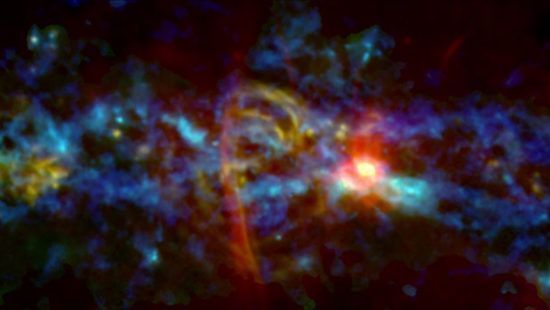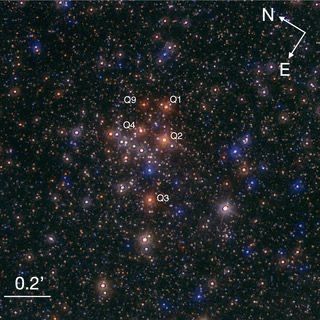In the early 1980s, Farhad Yusef-Zadeh (also known as Farhad Zadeh) — a professor of physics and astronomy at Northwestern University — came across mysterious magnetic filaments in the galaxy that consisted of cosmic ray electrons.
In what turned out to be a groundbreaking discovery, Professor Zadeh and his team used a new telescope and advanced technology to discover 10 times more filaments in the galaxy than were previously known.
[aesop_image img=”https://kayhanlife.com/wp-content/uploads/2022/02/IMG_3703.jpg” panorama=”off” credit=”Professor Farhad Yusef-Zadeh. ” align=”center” lightbox=”on” captionsrc=”custom” captionposition=”left” revealfx=”off” overlay_revealfx=”off”]
Prof. Zadeh was born in Iran and lived there for 18 years before moving to the U.S. after high school. He attended SUNY (State University of New York) at Stony Brook for undergraduate studies in physics, then got a Ph.D. in Astronomy from Columbia University.
He spent two years at NASA’s Goddard Space Flight Center, working as a National Research Council postdoctoral fellow, before joining the faculty of Northwestern University in 1988.
Prof. Zadeh recently spoke to Kayhan Life in a Zoom interview about his life and career.
Do you remember when and why you got interested in Astronomy?
When I was four or five years old, my grandfather passed away, and his death left a sad impression on me. I was stunned to realize that life was not forever.
In college, I took an astronomy course and learned that, like life, the sun and the solar system will not exist forever either. At some point in the future, maybe three or four billion years from now, the sun is going to expand. It will reach out to the Earth and Mars and wipe out all life on these planets.
That really made me feel the same way I felt when I was four years old, and excited me into knowing more about it.
My first interest was physics, which eventually led me to astronomy. I was fortunate to have had two great teachers in each field, who motivated and inspired me to further my studies and learn more about the Universe.
For the past 35 years, you have been studying mysterious strands made up of cosmic ray electrons, stretching up to 150 light years across the center of the Milky Way Galaxy. What is the mystery around these strands and where do they come from?
We have been studying these strands for a long time, and have known that these particles are moving and accelerating close to the speed of light. The trouble with these strands is that there is no obvious source for their acceleration. Generally, when you look at other cosmic rays, you may have a black hole or a supernova explosion as the source of their acceleration.
You and your team have found that there are ten times more strands than previously found. How was this discovery made and why is it significant?
The discovery was made by the MeerKat telescope in South Africa, which was recently commissioned. It’s an array of powerful telescopes looking at the nucleus of our galaxy. Because of their location in the Southern Hemisphere, we can observe for close to 12 hours a day over a big region of the sky.
What is important is that for the first time we can now do population studies of these filamentary structures. Up until now, scientists were basically studying a filament here and there. Now, we can study the entire system of filamentary structures with a good resolution and sensitivity, and are learning quite a bit about the mean properties of these filaments, as well as a lot of other characteristics that define the nature of these mysterious filaments.
The filaments within the cluster are apparently equally spaced. How do you explain this phenomenon?
I’m currently working with a colleague on a paper trying to figure out what you asked. This is the first time we are seeing this kind of characteristic. Many of these filaments are grouped together. We call them a cluster of filaments, and within each cluster, you have multiple parallel filaments that are running next to each other, which are equally spaced from each other. We think that it is related to some instability that is happening where you have large cosmic ray particles and, and weak magnetic fields.
On February 5, NASA announced that their new James Webb space telescope, 25 years in the making, had begun transmitting images of space. How is this telescope different from the Hubble telescope?
James Webb is a telescope on steroids. It is the biggest space telescope that has been flown, and has more than six times the surface area of the Hubble Space Telescope. There are three main advantages. One is that it is state of the art and very large, the second is that it can cover wavelengths in near-infrared and mid-infrared, and the third is that you can simultaneously [take an] image with two detectors.
You and your team have been assigned a time block to use the James Webb telescope. Your focus will be a black hole called Sagittarius A*. Why is this black hole significant and what do you expect to find?
In the center of our galaxy sits Sagittarius A* — a super massive black hole closest to us. Because of its proximity, it gives us a fantastic advantage to study the nature of super massive black holes.
The other advantage is that this black hole is varying in time. Every day or so, it has radiation flaring taking place, and we still don’t understand what the nature of these flares is. We think that it’s some type of an outflow, but it’s not incredibly violent, and each flare lasts about half an hour.
What is next for you both personally and professionally?
Professionally, I will be continuing my studies on the filaments we discussed, as well as studying the black hole at the center of the galaxy. I also have another program with collaborators with the Webb telescope to study how stars are formed near the supermassive black hole.
On a personal level, I have a lot of great memories of when I was in Tehran, and I like to write about my time there. I also would like to travel and see parts of the world that I haven’t been to.
As a final question, based on our level of technology, do you think organic life is rare or abundant in the Universe, and will we ever detect an extraterrestrial civilization?
What radio astronomy has shown is that there are clouds hundreds of light years away from us that have organic molecules in them and are carbon based. Molecular clouds eventually collapse and form new stars and then planets. We ourselves are carbon based. So, we are already seeing some signatures of carbon-based molecules in the very early phases of the formation, which are looking very promising.
As far as detecting extra-terrestrials, I think there’s a lot of work being done. SETI (Search for Extraterrestrial Intelligence Institute) is doing some fantastic work on detecting signals. Technology is advancing rapidly to process signals coming in and removing interferences. Also, the level that we discover exoplanets is increasing exponentially. We have found more than 1,000 planets outside our own solar system, and they have atmospheres, and sizes like Earth. We are simply not unique.
As far as detecting signals that connect us to another civilization, I think we must do this step by step first: find a planet with an atmosphere, see if there’s water in the atmosphere, and see if there are complex structures in the atmosphere. I think we’re in the right direction, but we will probably not meet ‘E.T.’ in our generation.
I do, however, remain hopeful that some day we will.











